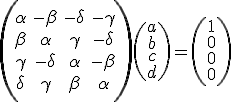|
fracmonk
|
 |
« on: June 21, 2010, 07:33:41 PM » |
|
Hi and welcome to a great challenge! In the 3-d gen, tru M, search for the holy grail thread began a discussion about an overlooked approach to dimensionality. FFP stands for "Full Field Properties" (all you'd expect old-fashioned math to do). Begins p. 12, paper in p. 14 for download, explains all. Some sample pix in implementation section. 2-d "MRI"- type x-sections available w .frm file for FractInt as well (still in grail section, also p.14). FractInt cannot do a true 3-d, I've lately found. What can be done is aforementioned 2-d x-sec slices, which can be generated as incremental frames of an animation to get a structural grasp of fractal objects (3-d index sets (4) and j-set views (innumerable)) involved. Finally carried out my fearsome threat to bring it here for review....
|
|
|
|
« Last Edit: June 21, 2010, 07:47:00 PM by fracmonk, Reason: elaboration »
|
 Logged
Logged
|
|
|
|
|
cKleinhuis
|
 |
« Reply #1 on: June 21, 2010, 07:44:21 PM » |
|
|
|
|
|
|
 Logged
Logged
|
---
divide and conquer - iterate and rule - chaos is No random!
|
|
|
|
fracmonk
|
 |
« Reply #2 on: June 21, 2010, 07:51:14 PM » |
|
Trifox- C'mon, give it a chance! At least, elaborate on  so I'm not so  right out of the box. Fair? |
|
|
|
|
 Logged
Logged
|
|
|
|
|
fracmonk
|
 |
« Reply #3 on: June 30, 2010, 09:21:40 PM » |
|
Not to be daunted by a full commercial-type bells-whistles project, a no-frills generating program that could do the M-set only would be a good start. I wrote something like that years ago in basic, but the math was wrong then, and the computer died of old age. Want to pore thru some 20-year-old 5 1/4 floppies looking for it? That's hopeless...anyway, my assistance is intermittently available for the ambitious among you. Any takers?
|
|
|
|
|
 Logged
Logged
|
|
|
|
|
kram1032
|
 |
« Reply #4 on: July 01, 2010, 10:12:12 AM » |
|
fracmonk: I actually agree with Trifox here... Can you write a little explanation on what your first post means?  (Maybe with Links and such as you seem to refer to a document or such...) |
|
|
|
|
 Logged
Logged
|
|
|
|
|
fracmonk
|
 |
« Reply #5 on: July 01, 2010, 07:21:05 PM » |
|
In my abbreviating haste, maybe i wasn't clear enough after all: THIS site (Fractalforums)- under 3d fractal generation> True 3d mandelbrot fractal (search for the holy grail continues). The discussion of this concept (a "legitimate" extension of complex numbers into more dimensions) began on its page 12 and continues still. On page 14 there is available my paper on it (which details the math soundly) and a .frm (FractInt formula) file which contains formulae for 2-d cross-section visualizations for all dimensional combinations. The messages in the thread elaborate the concepts somewhat. In the "3d implementation" thread, there are very basic example pix, though I'd have done better to keep it all in one place (sorry about that). Can't say more without repeating myself painfully. Hope that's enuf, if not, scream!
But be patient, since i can't be around as much as I'd like...
Also, this is not toy time. You need to know M-set basics...and I would prefer no trigonometric confabulation. This is very simple and algebra-based. I see no particular reason why the way Fractint is structured cannot be built onto.
|
|
|
|
« Last Edit: July 01, 2010, 09:48:44 PM by fracmonk, Reason: even more clear (hopefully) »
|
 Logged
Logged
|
|
|
|
|
Schlega
|
 |
« Reply #6 on: July 11, 2010, 11:13:00 AM » |
|
Fracmonk, I read your paper and wrote a ChaosPro file implementing your system. This was the result:  Here is the code, if you want to play with it for yourself. Fracmonk(QUATERNION) {
parameter real bailout;
real x1,x2,y1,y2,z1,z2,w1,w2;
quaternion c;
quaternion squar(quaternion q)
{
x1 = part_r(q);
y1 = part_i(q);
z1 = part_j(q);
w1 = part_k(q);
x2 = x1*x1 - y1*y1 - z1*w1*2;
y2 = x1*y1*2 + z1*z1 - w1*w1;
z2 = (x1*z1 - y1*w1)*2;
w2 = ( x1*w1 + y1*w1)*2;
q = quaternion(x2,y2,z2,w2);
return(q);
}
void init(void)
{
c = pixel;
z=pixel;
}
void loop(void)
{
z = squar(z) + c;
}
bool bailout(void)
{
return(|z|<bailout);
}
void description(void)
{
this.title = "fracmonk";
bailout.caption = "Bailout Value";
bailout.default = 4.0;
bailout.min = 1.0;
bailout.hint = "Defines the bailout radius: As soon as a pixel falls outside a circle with this radius, the iteration stops.";
}
}Also, this system is not quite a field, since there are elements without a multiplicative inverse ( e.g.  ) |
|
|
|
|
 Logged
Logged
|
|
|
|
|
fracmonk
|
 |
« Reply #7 on: July 13, 2010, 06:13:58 PM » |
|
Schlega- I have a problem w. your "z2=... and w2=... lines. Are you sure your program will distribute correctly? Why take chances? Real,i,j,+ij are very different creatures with unique roles and relations with one another. Also, if you examined the paper I made available, there is a *reliable division method*, which means every (up to) 4-component value has a determinable multiplicative inverse. That's what makes it special, that's the point of it. The division is unavoidably unwieldy, due to the "curse of higher dimension", but sound. Pretty cool picture- may be right after all (I would have to print and study your code more closely, and I'm forced to guess (unwise) at ChaosPro's syntax, which I cannot do until later, anyway, for access reasons)...but which 3 of 4 dims does it represent, and have you set iterations high enough to purge the vast majority of close escapees?
|
|
|
|
« Last Edit: July 13, 2010, 06:33:39 PM by fracmonk, Reason: clarity »
|
 Logged
Logged
|
|
|
|
|
Schlega
|
 |
« Reply #8 on: July 14, 2010, 09:10:39 AM » |
|
Schlega- I have a problem w. your "z2=... and w2=... lines. Are you sure your program will distribute correctly? Why take chances? Real,i,j,+ij are very different creatures with unique roles and relations with one another. I'm sure that ChaosPro understands order of operations, so it will always evaluate the expression in parenthesis before multiplying. There's no distributing involved. Also, the variable type is quaternion simply because that is the name Chaos pro uses for variables with four components. I used all of the relationships between the axes to determine the components of the squaring fuction should be. Also, if you examined the paper I made available, there is a *reliable division method*, which means every (up to) 4-component value has a determinable multiplicative inverse. That's what makes it special, that's the point of it. The division is unavoidably unwieldy, due to the "curse of higher dimension", but sound. That formula works for most values, but the denominator you obtain is not strictly positive. For example, *(1+i-\sqrt{2}j) = 1+i-\sqrt{2}j +i +i^2-\sqrt{2}ij + \sqrt{2}j +\sqrt{2}ij -2j^2 = 0) Pretty cool picture- may be right after all (I would have to print and study your code more closely, and I'm forced to guess (unwise) at ChaosPro's syntax, which I cannot do until later, anyway, for access reasons)...but which 3 of 4 dims does it represent, and have you set iterations high enough to purge the vast majority of close escapees?
That was the slice with w=0 ( using x +yi +zj +wij), and it only had 10 iterations. I tried bumping it up to 100 iterations and looking at all four of the coordinate slices. My computer is painfully slow, so I'm reluctant to bump the iterations too much higher than that. w = 0:  z = 0:  y = 0:  x = 0:  |
|
|
|
|
 Logged
Logged
|
|
|
|
|
fracmonk
|
 |
« Reply #9 on: July 14, 2010, 04:41:40 PM » |
|
Schlega- My deepest apologies for the first part of my last msg to you. I tested that, and it saves time slightly, and so, I spent time this AM making up a new and improved .frm file for the FractInt 2-d in the "grail" thread. Still have to put it there.
Most of my probs will come from rushing...
The conjugation example you gave, I *scrambled* to do on paper really quickly, and got 2(sqrt(2))j, not zero, but the context of division by zero here would be infinity, or, as one approaches zero, the value becomes large. Will happen in some cases.
I've been looking at close stuff, in high iterations in 2-d: sometimes up to 1,000,000, but I guess you've already seen that it's generally not a smooth object. I've used min 1000 just to look around, but that's 2-d, a completely different world...
|
|
|
|
|
 Logged
Logged
|
|
|
|
|
fracmonk
|
 |
« Reply #10 on: July 14, 2010, 08:40:43 PM » |
|
Schlega- Mentioned in my last post that I got a different answer to your conj. example. I was absolutely WRONG again, and it IS zero. I was once again very rushed. But this may mean that it isn't a field after all, and only a ring (this leaves me truly brokenhearted!). That does not necessarily mean that it is not superior to quaternions for this task anyway. So if I had to guess, (again, unwise) there are probably at least 3 other such (strong) infinities. Are you familiar with Curt McMullen's work with complex functions involving division on the complex plane? In mappings of them, it is inevitable that the origin or other places that are not infinity ACT like infinity in the context I mentioned in the last post. Dimensional extension apparently can generate more. Usually, in such multiply connected objects, there is/are an infinity of them, and they are spongelike, like the magnetic fractal. But this situation still does not apply to the M-set, which has no division anyway. We still would have commutative, associative, and distributive properties as an advantage over quat.
Believe me, this is not my day...but out of respect for your astuteness, I have made a second special trip to town to address what absolutely must be if good math is to be done...good eyes, Schlega!
Unfortunately, I'll have to wait until I can get hard copy of your latest pix to try to find my cross-sections in them.
Be patient with me, o.k? You probably have the first pix of the truest extensions of M there can be. It wouldn't hurt to up the iterations and really make it CRAWL! The increased accuracy is worth it.
ALMOST Full Field Properties, AFFP? I try not to take myself too seriously...be good, see ya...
|
|
|
|
|
 Logged
Logged
|
|
|
|
|
fracmonk
|
 |
« Reply #11 on: July 16, 2010, 04:42:11 PM » |
|
Schlega- Finally got to spend the time to give this decent consideration. For symmetry's sake, there are a total of 8 such infinity holes of equal strength in the division space, 7 more complementing your example. Found them by changing signs systematically, looking for balance, considering angular relationships of direction and distance to 4 axes. Wondering by what method you obtained the first one, so I can get a handle on whether they are special cases as the strongest of many, or if they have other equals all over. Strange space all the same, worth exploring, and I don't think it makes the division operation meaningless. It is true behavior.
|
|
|
|
|
 Logged
Logged
|
|
|
|
|
Schlega
|
 |
« Reply #12 on: July 17, 2010, 05:31:27 AM » |
|
Schlega- Finally got to spend the time to give this decent consideration. For symmetry's sake, there are a total of 8 such infinity holes of equal strength in the division space, 7 more complementing your example. Found them by changing signs systematically, looking for balance, considering angular relationships of direction and distance to 4 axes. Wondering by what method you obtained the first one, so I can get a handle on whether they are special cases as the strongest of many, or if they have other equals all over. Strange space all the same, worth exploring, and I don't think it makes the division operation meaningless. It is true behavior.
Before I found your paper, I attempted to find a formula for v -1 on my own. I set  , then attempted to solve for  .  can be written as:  I then calculated the determinant and found it could be written as : ![(\alpha^2 +\beta^2)^2 + (\gamma^2 +\delta^2)^2 + 4[(\delta^2-\gamma^2)\alpha\beta +(\alpha^2 - \beta^2)\gamma\delta]](/cgi-bin/mimetex.cgi?(\alpha^2 +\beta^2)^2 + (\gamma^2 +\delta^2)^2 + 4[(\delta^2-\gamma^2)\alpha\beta +(\alpha^2 - \beta^2)\gamma\delta]) That's too complicated for me to find all the zeros, so I tried setting  , then solved for  . |
|
|
|
|
 Logged
Logged
|
|
|
|
|
fracmonk
|
 |
« Reply #13 on: July 19, 2010, 07:09:41 PM » |
|
S- Gotta definitely take a good look at that, but I found this:
j=(1+i)/sqrt(2), sqrt(2)j=1+i, 0=1+i-sqrt(2)j
Going to update paper w. this stuff...no time now, though, sorry!
|
|
|
|
|
 Logged
Logged
|
|
|
|
|
fracmonk
|
 |
« Reply #14 on: July 20, 2010, 07:14:35 PM » |
|
Schlega- Is that a matrix? I'm not familiar and need to decode it- that is, I'm sure I'd know what was what there if I knew how to read it. You'd be surprised what I DON'T know, I'm largely an untrained primitive...who knows, maybe I can figure by its patterns w.o. help...a puzzle to solve, like that...I'll be in touch.
|
|
|
|
|
 Logged
Logged
|
|
|
|
|


















